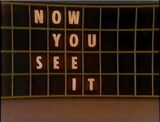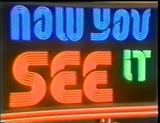| Aired | |
| Pilot: October 1973 CBS Daytime, April 1, 1974 – June 13, 1975 | |
| Number of episodes | |
| 308 | |
| Run time | |
| 30 Minutes | |
| Host | |
| Jack Narz | |
| Announcers | |
| Johnny Olson Gene Wood | |
| Origination | |
| CBS Studio 33, Television City, Los Angeles, California | |
Now You See It was a game show based on Wordsearch.
Game Format[]
The game board had four rows ("lines") with 14 letters of the alphabet ("positions") in each row. Host Narz read questions with single-word answers that were concealed within the jumble of letters on the board for that round. The answers on the board were always written horizontally from left to right.
Main Game[]
There were two formats:
Format #1[]
Elimination Round[]
This first round began with four new players randomly split into two teams with one "outside" and one "inside" player each. The "outside" players turned their backs to the board as Narz read a question. The first "inside" player to ring in would say which line the correct answer appeared on. If the correct line was given, the "outside" player for that team turned around to give the position number and the word. If the wrong line was guessed, the other team had a free guess. If the correct position and answer was given, the team scored points equal to the sum of the line and position numbers (Example: a word on line 3 and in position 1 was worth 4 points); otherwise, no one scored for that word. Halfway through the round, the inside and outside players switched roles, and the team in the lead after twelve questions won the round.
Semi-Finals[]
The contestants on the winning team now competed against each other. A string of 16 concealed letters was shown to the contestants, and Narz read a crossword-style clue. The 16-letter string began to reveal one letter at a time until someone rang in and answered correctly, or only one letter was left in the word. If a contestant rang in and gave a wrong answer, the opponent was given a free guess before more letters were revealed. If they too came up with a wrong answer, the word would continue to be revealed. If nobody guessed the word with one letter left, it was revealed. Narz then read another clue, and began revealing letters; the next answer used letters from the end of the previous answer in the string. The first player to guess four words correctly won the round and a prize package. (In the first two weeks, no prize package was given to the winner. Also, during the third week, it took five points to win the round; this would become permanent when the second format was introduced.)
Finals[]
The winner of the Semi-Finals round competed against the show's champion in this round, which was played like the elimination round, but with no partners. Contestants had to give the line, position number and correct answer to score.
Originally, a correct answer allowed a contestant to answer subsequent questions without ringing in until he/she gave a wrong answer, at which point their opponent had an opportunity to answer and steal control. If the opponent missed as well, the next question would be a toss-up. This was scrapped after the first episode, and all questions became toss-ups.
The contestant with more points after six questions won the game and played the "Solo Game" for a cash jackpot.
Bonus Words[]
Starting on September 23, 1974 and continuing until the adoption of the second main game format, contestants were asked to scan the board and write down a word from it each on an index card at the beginning of each half of the Elimination Round, and the Finals. Players would score 10 bonus points if they correctly answered a question with one of their "bonus words", but had to reveal that word when found, and couldn't return to it afterwards.
Format #2[]
Starting on December 20, 1974 and for the rest of the run, the format was changed. The Elimination Round was dropped, and two new players competed in the Semi-Finals, now renamed the Qualifying Round and played the same way as the first version. At this point, five points were needed to win. The Finals was renamed the Championship Round and was also played the same way except point values were doubled when someone reached 50 points (Example: a word on line 4 and in position 5 multiplied by 2 was worth 18 points), and the first player to reach 100 points played the Solo Game. Under this "straddling" format, games could stop at the end of one episode and resume at the beginning of the next.
Contestant Area[]
Though not acknowledged on air, it was split into two colors: green & blue. Each side had a giant triangle which lit up in neon lights when someone rang-in; it also had matching scoreboards and ring-in boxes (the latter were removed for the second format). During the final round, the champion sat in the green position and the challenger sat in the blue one (these were sometimes swapped during the first format); as a side note the lady players from the first show wore dresses matching their backdrops. It was also a two-leveled area with the second level dubbed the "Champion's Gallery" where the returning champion sat until the final round.
Solo Game[]
In this bonus round, the winner was given a new board and one minute to find ten words on it. Once Narz read a clue to one of the words, the contestant used an electronic pencil to circle it and had to call it out to receive credit. He/She could pass at any time and return to that clue later. Each correct answer was worth $100, and if all ten words were found before time expired, the contestant won all the money in the Now You See It Bank, which started at $5,000 and grew by $1,000 every day until won or reaching CBS' $25,000 limit.
A champion would immediately retire after winning the jackpot, thus making the player they beat in the finals/championship round (the semifinals/qualifying round if the current champion was defeated) the designated champion for the next game.
Personnel[]
- Host: Jack Narz
- Announcer: Johnny Olson, Gene Wood
- Executive Producer: Frank Wayne
- Producer: Buck D’Amore
- Director: Paul Alter
- Set Designer: James Agazzi
Broadcast History[]
April 01, 1974-June 13, 1975 (CBS Weekdays at 11:00 a.m.)
Trivia[]
Jack Narz hosted the syndicated revival of Concentration while working on this show.
The theme song (proued b Quincy Jones) was originally written for Bill Cosby's short-lived 1972-1973 CBS Variety series, The New Bill Cosby Show.
The pilot was taped in October 1973, and featured six players instead of five, as well as a lack of neon lights on the front of the desks.
A 1974 test episode to try out the format change aired on Buzzr as part of their "Lost and Found" week on September 9, 2015.
In 2015, this was one of the six potential candidates for Buzzr's Pick & Play Sunday Night Lineup along with: Trivia Trap, Sale of the Century (Perry), Wordplay, Double Dare (Trebek) and Beat the Clock (Hall) but failed to generate enough viewers to make it on the schedule, however, it was added to Buzzr's lineup in 2017.
NOTE: In the "Pick & Play" promo ad, it featured a screengrab of the intro from the 1989 version instead of the original 1974 version.
Music[]
Main - "Chump Change" by Quincy Jones & Bill Cosby (also used in both the 1985 pilot & the 1989 version respectively)
Alternative Main - by Edd Kalehoff
International Versions[]
Main Article: Now You See It/International
Merchandise[]
Main Article: Now You See It/Merchandise
Photos[]
Main Article: Now You See It/Photos
Episode Status[]
See Also: Now You See It/Episode Guide
This series presumably exists in its entirety, and has aired on GSN and Buzzr at various times in the past.
See Also[]
Now You See It (1985 pilot)
Now You See It! (1989)
Video[]

Now You See It - 1974

Now You See It 1974 CBS Debut

Now You See It - May 15, 1974

Now You See It - March 1975 Episode

Now You See It - Ep 308 - Finale Episode - June 13, 1975

3 Now You See It

Now You See It Promo

Now You See It - 1974 ticket plug, closing credits


